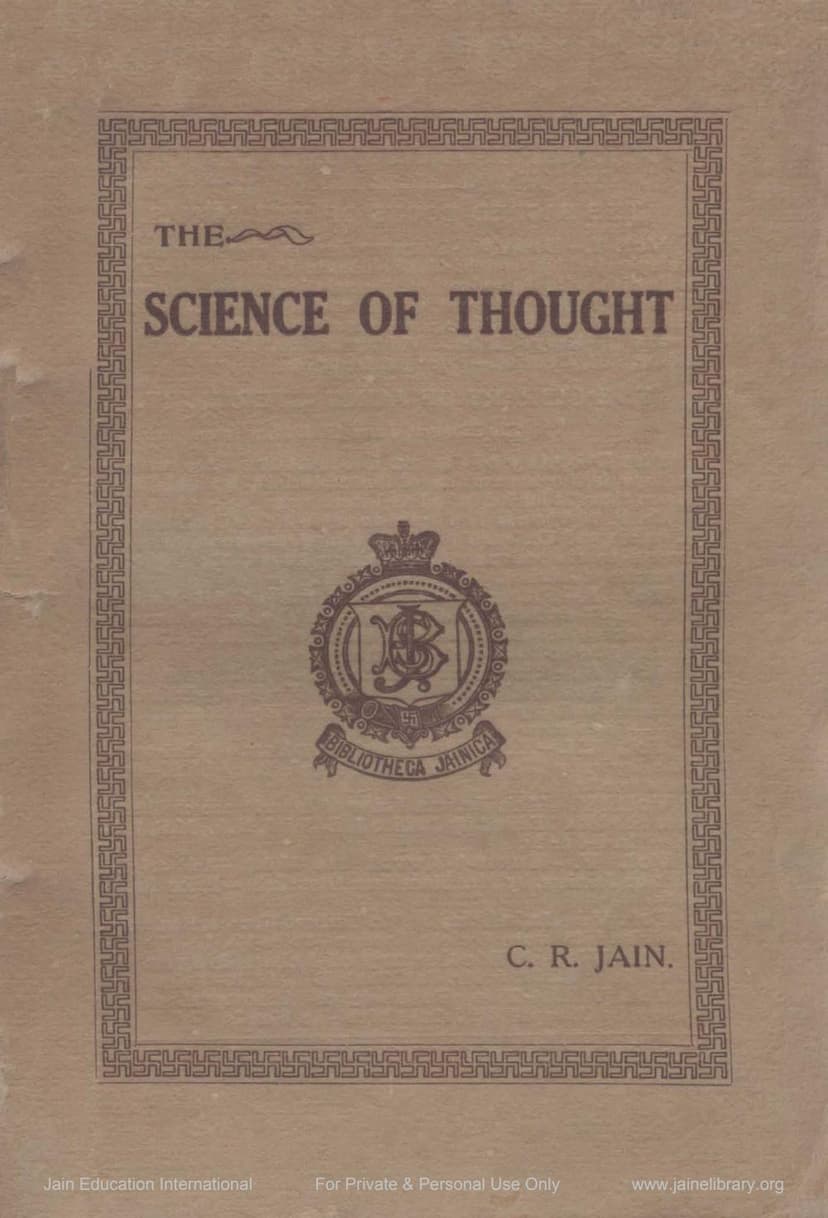Nyaya Science Of Thought
Added to library: September 2, 2025

Summary
Here's a comprehensive summary of "The Science of Thought" by Champat Rai Jain, based on the provided text:
"The Science of Thought," authored by Champat Rai Jain, is an exposition of Jain philosophical perspectives on knowledge (Jnana) and the workings of the mind, particularly in relation to logical inference. While not a direct translation, it draws heavily from two earlier works: "Pariksa Mukha" by Sri Manikyananda (9th century CE) and "Nyaya Dipika" by Yati Dharmabhusana (c. 1600 AD).
The book aims to present the Jain view on accurate thinking and the acquisition of right knowledge. Jainism defines right knowledge as that which eradicates ignorance, categorizing ignorance into three forms: doubt (sansaya), wrong knowledge (viparyaya), and absence of knowledge (anadhyavasaya). Pramana, or valid knowledge, is defined as knowledge free from these blemishes, accurately cognizing objects as they exist.
A core tenet presented is that all things are knowable. This is because existence implies provability, and unprovable things cannot exist. Knowledge, in the Jain view, is inherent to the soul; it is not an external quality acquired or a separate entity that attaches to the soul. The soul itself is the substance of consciousness. The book argues against the idea of consciousness as a separate quality that inheres in or attaches to the soul, emphasizing that consciousness is the very nature of the soul.
The process of acquiring knowledge and accurate thought involves several steps:
- Uddeşa: Naming or identifying the subject of inquiry.
- Lakṣana (Definition): Describing an object by its distinguishing feature. These features can be inseparable (atmabhuta) or separable (anamabhuta). A true lakṣana must avoid faults like avyapti (non-prevalence), ativyapti (over-prevalence), and asambhavya (contradiction).
The book asserts that every living being possesses the capacity for infinite knowledge. This stems from the knowability of all things and the soul's inherent nature as consciousness. While all souls have the potential for omniscience, the actualization of this potential is limited by karmic obstructions. Education is described as the process of "drawing forth" knowledge from within the depths of consciousness, as karmic bonds are loosened.
Pramana (valid knowledge) is distinguished from error. It can be direct (Pratyaksha) or indirect (Paroksha).
- Pratyaksha Pramana is pure, unclouded clarity of knowledge, experienced rather than described. It is distinguished from mere perception (nirvikalpaka), which may be unassured. The book argues that senses, light, and physical contact are not the direct causes of Pratyaksha Pramana, but rather instruments that facilitate the stimulus to the soul.
- Pratyaksha is further divided into Samvyavaharika (empirical, involving senses and mind, also called Mati-jnana) and Paramarthika (pure intuition, independent of senses and mind). Paramarthika is further divided into Sakala (omniscience) and Vikala (limited intuitive knowledge like Avadhi - clairvoyance, and Manahparyaya - telepathy).
- Paroksha Pramana is valid knowledge not characterized by the clarity of Pratyaksha. It encompasses:
- Smriti (memory)
- Pratyabhijñāna (recognition, a combination of perception and memory)
- Tarka (knowledge of invariable relationships, the basis of inference)
- Anumana (inference, knowing one thing from another)
- Shruta Jnana (knowledge acquired through interpretation of signs, words, etc., with Agama or Scripture being the highest form, as it is the word of an omniscient being).
The book emphasizes the Jain concept of Anekantavada (many-sidedness) as crucial for valid knowledge. Understanding things from multiple viewpoints prevents one-sided and imperfect knowledge.
The book also delves into the nature of inference (Anumana), distinguishing between Svarthanumana (inference for oneself) and Pararthanumana (inference for others). It outlines the structure of syllogisms and critiques the five-limbed syllogism favored by some schools, advocating for a simpler, more natural two-limbed structure (pratijna and hetu). Various types of logical relationships (Vyapti) that form the basis of inference are discussed, including cause-effect, antecedence-consequence, and co-existence.
Finally, the text addresses fallacies (Abhasa) in reasoning, categorizing them into Pramanabhasa (fallacy of valid knowledge), Tarkabhasa (fallacy of reasoning), Pakshabhāsa (fallacy of proposition), Hetvabhāsa (fallacy of reason), Drstantabhāsa (fallacy of illustration), Balaprayogabhasa (fallacy of childish reasoning), Sankhyabhāsa (fallacy regarding sources of knowledge), and Agama abhasa (fallacy of scripture). Each category is explained with examples of how invalid reasoning can appear truthful.
In essence, "The Science of Thought" provides a detailed exploration of Jain epistemology, focusing on the nature of knowledge, the validity of means of knowledge, the structure of reasoning, and the spiritual path towards omniscience through the removal of karmic obstructions.